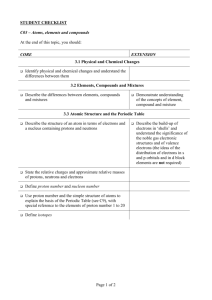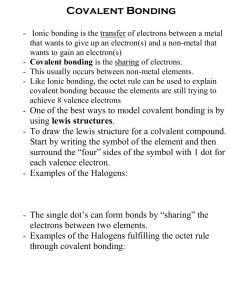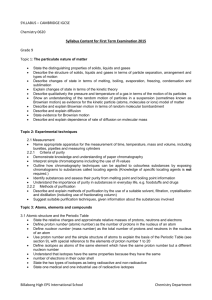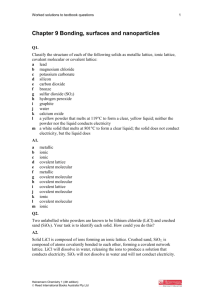Comparing the Similarities and Differences of Ionic vs
advertisement
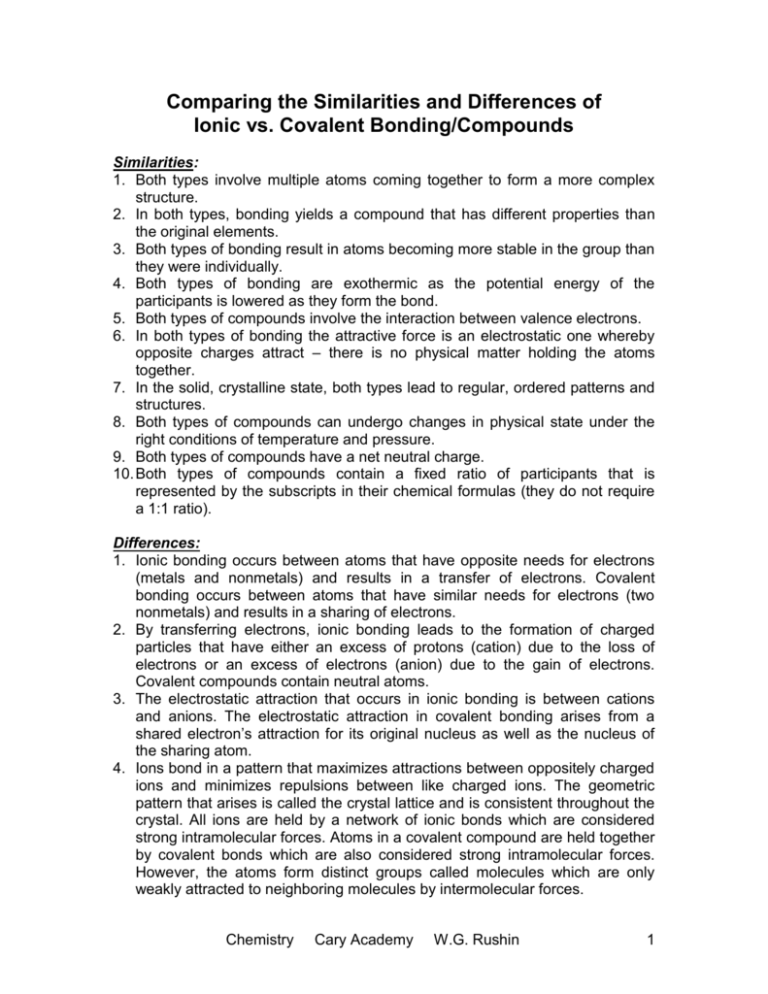
Comparing the Similarities and Differences of Ionic vs. Covalent Bonding/Compounds Similarities: 1. Both types involve multiple atoms coming together to form a more complex structure. 2. In both types, bonding yields a compound that has different properties than the original elements. 3. Both types of bonding result in atoms becoming more stable in the group than they were individually. 4. Both types of bonding are exothermic as the potential energy of the participants is lowered as they form the bond. 5. Both types of compounds involve the interaction between valence electrons. 6. In both types of bonding the attractive force is an electrostatic one whereby opposite charges attract – there is no physical matter holding the atoms together. 7. In the solid, crystalline state, both types lead to regular, ordered patterns and structures. 8. Both types of compounds can undergo changes in physical state under the right conditions of temperature and pressure. 9. Both types of compounds have a net neutral charge. 10. Both types of compounds contain a fixed ratio of participants that is represented by the subscripts in their chemical formulas (they do not require a 1:1 ratio). Differences: 1. Ionic bonding occurs between atoms that have opposite needs for electrons (metals and nonmetals) and results in a transfer of electrons. Covalent bonding occurs between atoms that have similar needs for electrons (two nonmetals) and results in a sharing of electrons. 2. By transferring electrons, ionic bonding leads to the formation of charged particles that have either an excess of protons (cation) due to the loss of electrons or an excess of electrons (anion) due to the gain of electrons. Covalent compounds contain neutral atoms. 3. The electrostatic attraction that occurs in ionic bonding is between cations and anions. The electrostatic attraction in covalent bonding arises from a shared electron’s attraction for its original nucleus as well as the nucleus of the sharing atom. 4. Ions bond in a pattern that maximizes attractions between oppositely charged ions and minimizes repulsions between like charged ions. The geometric pattern that arises is called the crystal lattice and is consistent throughout the crystal. All ions are held by a network of ionic bonds which are considered strong intramolecular forces. Atoms in a covalent compound are held together by covalent bonds which are also considered strong intramolecular forces. However, the atoms form distinct groups called molecules which are only weakly attracted to neighboring molecules by intermolecular forces. Chemistry Cary Academy W.G. Rushin 1 5. There is no distinctly individual unit in an ionic crystal. However, there is a definite, fixed ratio between the cations and anions present. This ratio is used to come up with a “formula unit” which represents the base ratio by way of subscripts (AlCl3). The crystal itself may truly have 1 billion zillion aluminum ions and 3 billion zillion chloride ions. Covalent compounds contain individual units called “molecules” that also have a fixed ratio of participants (CO 2), however, the subscripts in this case represent the absolute number of atoms present in each molecule of the compound. 6. It is more difficult to break apart a salt because its structure is entirely strong intramolecular forces (ionic bonds). Molecules only have strong intramolecular forces (covalent bonds) holding the individual group together. The intermolecular attractions that can hold one molecule to its neighbor is weak therefore the molecules can be easily separated by increasing their motion by raising their kinetic energy (temperature). Salts have high melting and boiling points so that are found as solid crystals at normal conditions. Molecules melt and boil at much lower temperatures. The everyday physical state changes that you notice in your surroundings are the molecules because they can melt, freeze, evaporate, and condense at more normal temperatures. 7. Due to the fact that they are made up of charged particles, salts can conduct electricity when their ions are mobile (molten or dissolved in water). Molecules are neutral and can not conduct electricity. They may appear to conduct electricity if they react with water molecules to form ions (called ionization reaction). 8. Electron clouds overlap in covalent bonding. 9. In covalent bonding, two atoms of the same element can bond together. 10. There are more covalent compounds in nature than ionic. 11. Living things are covalently constructed. 12. A greater percentage of salts have a high solubility in water compared to molecules. 13. Molecules tend to have a greater number of different participants as compared to salts. Chemistry Cary Academy W.G. Rushin 2


